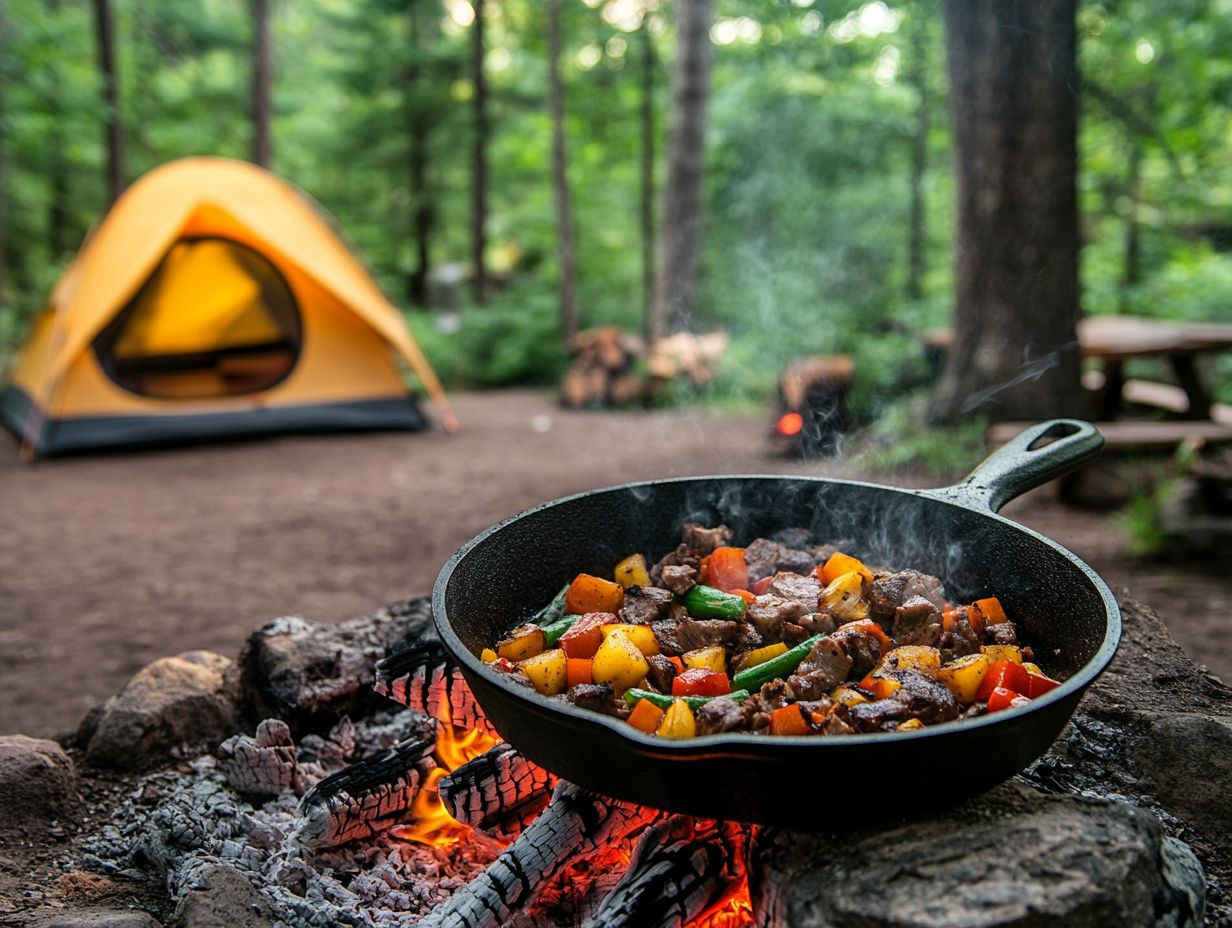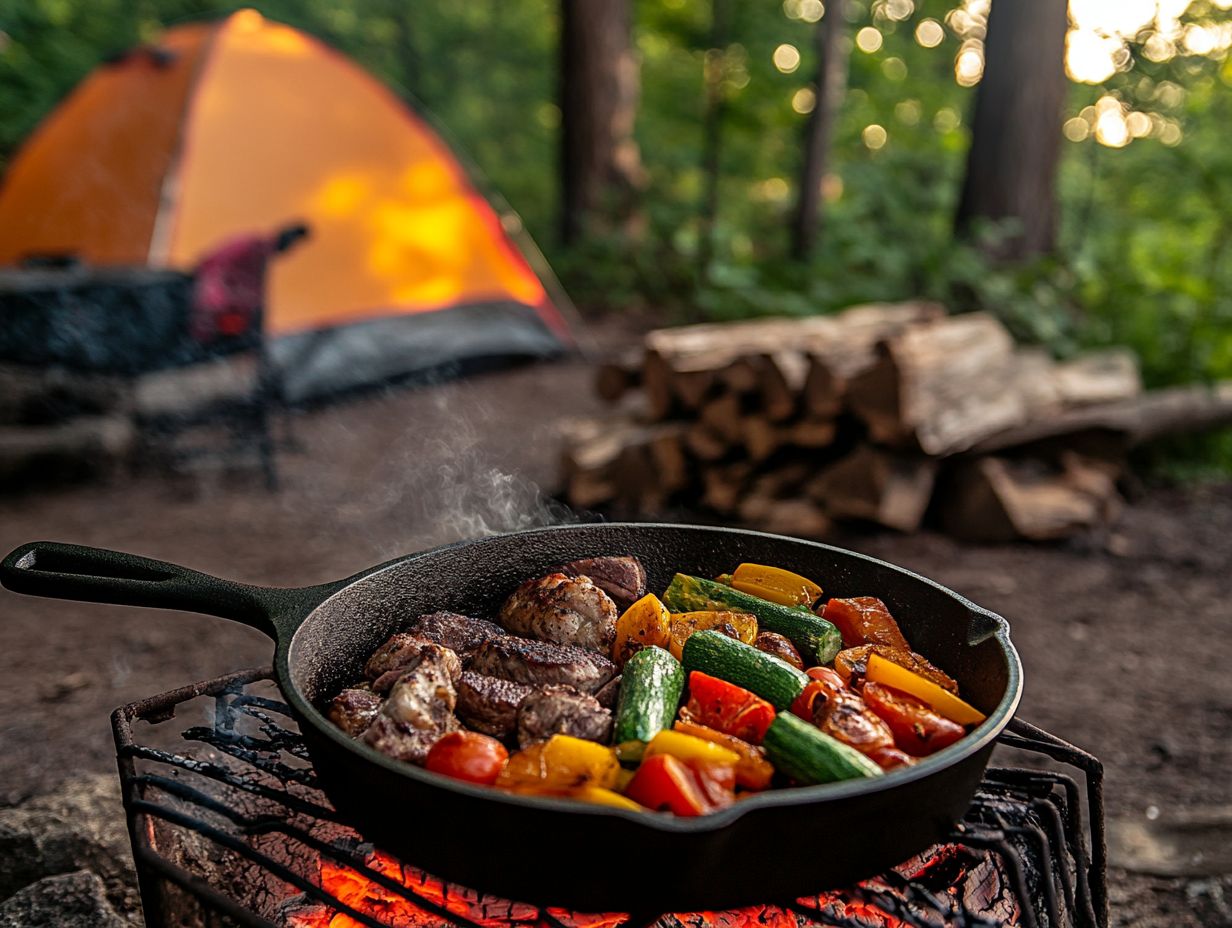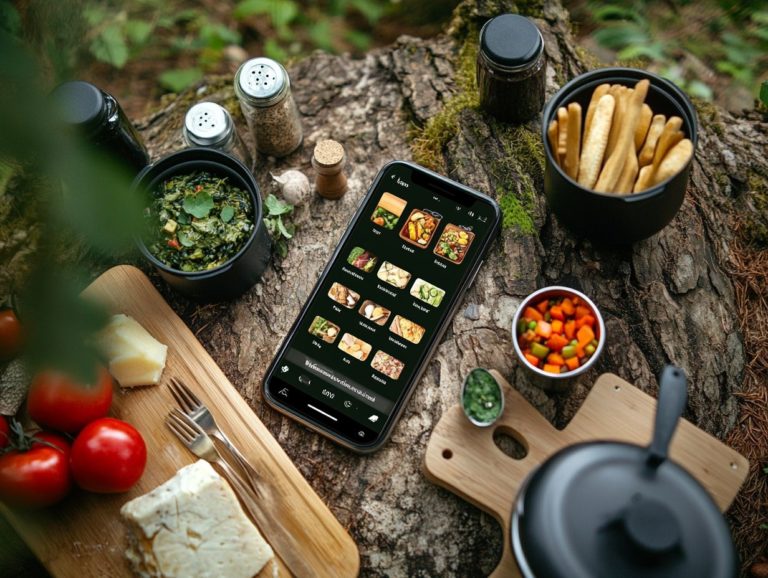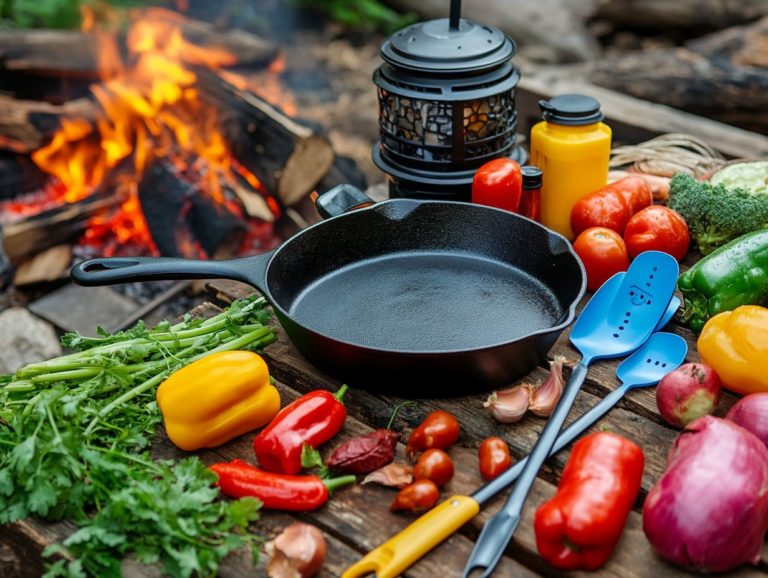How to Use a Cast Iron Skillet for Camping Meals
Camping meals can be a delightful adventure. A cast iron skillet can elevate that experience to new heights!
This versatile cooking tool retains heat remarkably and enhances the flavors of your dishes.
You ll learn how to choose the perfect skillet for camping trips. Plus, you’ll discover how to prepare, season, and maintain it for years of outdoor cooking fun.
Be ready to tackle common challenges along the way. Transform your camping meals into something extraordinary!
Contents
- Key Takeaways:
- Benefits of Using a Cast Iron Skillet for Camping
- Choosing the Right Cast Iron Skillet
- Preparing Your Cast Iron Skillet for Camping
- Cooking with a Cast Iron Skillet at the Campsite
- Cleaning and Storing Your Cast Iron Skillet
- Troubleshooting Common Issues
- Frequently Asked Questions
- What is the best way to season a cast iron skillet for camping meals?
- Can I use soap to clean my cast iron skillet while camping?
- What types of meals can I cook in a cast iron skillet while camping?
- How do I prevent my cast iron skillet from rusting while camping?
- Can I use a cast iron skillet on a propane camping stove?
- Are there any special precautions I should take when using a cast iron skillet for camping meals?
Key Takeaways:

- A cast iron skillet is a versatile and durable tool for cooking outdoors. Its even heat distribution and non-stick surface make it ideal for camping meals.
- When picking a skillet, consider its size, weight, and material to ensure suitability for outdoor cooking.
- Proper seasoning, cleaning, and storage ensure your skillet lasts and prevents rusting or food sticking.
Benefits of Using a Cast Iron Skillet for Camping
A cast iron skillet offers numerous benefits that elevate your outdoor cooking adventures. It’s durable, heat-resistant, and ensures even cooking perfect for satisfying one-pot camping meals!
Whether you’re making Dutch oven chili or Blueberry Banana Pancakes, these skillets enhance flavors and simplify cooking. Plus, easy cleanup means more time enjoying your camping experience.
Choosing the Right Cast Iron Skillet
Selecting the right cast iron skillet for camping is crucial. Consider its size, weight, and design to meet your cooking needs.
The right skillet influences how well you prepare meals and its durability affects its lifespan. Pick one that lets you explore a variety of one-pot meals!
If cooking for a small group, choose an 8 to 12-inch skillet. A heavier skillet is great for campfire cooking, but remember that lighter options are easier to transport.
Maintenance is vital; a well-seasoned skillet boosts flavor and reduces sticking. If you love breakfast, a 10-inch skillet works for a range of dishes!
Try making cast iron cornbread or savory paella, adding a gourmet touch to your outdoor experience!
Factors to Consider
Choosing a cast iron skillet for your camping trip involves several important factors. Consider the skillet’s size and weight; larger skillets can be heavy to carry, while smaller ones might not accommodate generous meals like Dutch Oven Chicken Marbella or Sweet Potato Peanut Stew.
The skillet’s design and material quality significantly impact its performance in outdoor cooking. A well-crafted skillet with thick walls retains heat effectively, ensuring even cooking. Lighter models may lead to uneven results. The skillet’s weight also plays a crucial role in portability during hikes. A thicker material can withstand high heat, making it ideal for searing meats or achieving that crispy crust on your breakfast hash.
Recipes like Campfire Frittata and Skillet Cornbread showcase the skillet’s versatility. Whether you’re saut ing vegetables or baking, a quality cast iron skillet can elevate simple camp meals into delightful culinary adventures. Consider trying Chilaquiles for a taste of Mexico in your outdoor cooking.
Preparing Your Cast Iron Skillet for Camping

Get your cast iron skillet ready for camping! Follow these essential steps to keep it performing well and lasting long. A well-seasoned skillet enhances food release and makes cooking and cleanup a breeze during your outdoor adventure.
Whether you re crafting a delightful Chickpea Hash or indulging in Dutch Oven French Toast, knowing how to season and maintain your skillet maximizes the joys of camp cooking.
Start by scrubbing the skillet with hot water and a stiff brush or a gentle scrubber if it s delicate to remove any food residue or rust. Rinse thoroughly and dry it; this step is critical to prevent rust. You might even place it over low heat briefly to ensure it s completely dry.
Next, apply a thin layer of vegetable oil using a paper towel to coat evenly, avoiding pooling. This step is vital for creating that coveted non-stick surface. Then, bake the skillet upside down in a hot oven for an hour. This process allows the oil to bond, creating a strong finish that enhances your meals.
Mastering this technique elevates dishes like a savory Frittata, ensuring every culinary experience is enjoyable.
Seasoning and Maintaining Your Skillet
Seasoning and maintaining your cast iron skillet is essential for outdoor cooking. Proper seasoning provides a non-stick surface and helps prevent rust, making it a vital step in your camp cooking prep. Regular cleaning, including smart techniques for quick cleanup after meals like Campfire Nachos or Sausage & Tortellini Soup, ensures your skillet performs beautifully throughout your camping adventure.
To effectively season your skillet, clean it with hot, soapy water and a stiff brush to eliminate any old seasoning or food residues. Rinse and dry thoroughly, then apply a thin layer of vegetable oil or shortening over the cooking surface, including the handle and outer surfaces.
Next, place it upside down in an oven preheated to 375 F for about an hour. This process allows the oil to bond, creating a durable, protective layer.
While camping, avoid soaking the skillet in water. Instead, wipe it clean with paper towels and scrub away stubborn bits using salt. Always ensure the skillet is completely dried and lightly oiled before storing it to prevent rust.
For delicious recipes, think about searing meats, baking cornbread, or whipping up a hearty frittata. Each one showcases the versatility of this critical cookware. What camping recipes are you excited to try with your skillet?
Don’t forget to explore options like Beef Stroganoff for a comforting meal!
Cooking with a Cast Iron Skillet at the Campsite
Cooking with a cast iron skillet at the campsite elevates your outdoor meals. You can create a variety of delicious one-pot dishes that are easy and satisfying. From classic Dutch oven recipes to innovative outdoor cooking techniques, a cast iron skillet is versatile enough to handle everything from Red Beans & Rice to Dutch Oven Blueberry Cobbler. For the best options, check out the best cast iron cookware for campers. Embracing the art of camp cooking ensures your camping trip is unforgettable as you savor the flavors of home-cooked meals under the stars.
With a cast iron skillet in hand, you unlock many cooking methods like frying, saut ing, and baking. These are ideal for crafting hearty breakfasts over a campfire think scrambled eggs with veggies or flaky cinnamon rolls. You can also do simmering stews, grilling meats, or even roasting vegetables, all of which enhance your outdoor dining experience.
Whether you re creating a savory jambalaya or a delightful apple crisp, the robust nature of cast iron not only withstands the challenges of outdoor cooking but also adds an irresistible flavor that makes each bite special, showcasing the beauty of Dutch oven meals.
Techniques and Recipes for Delicious Meals
Mastering campfire cooking techniques can truly elevate your culinary game. You can whip up mouthwatering meals like Dutch Oven Chili & Cornbread or Lentil Sloppy Joes all with just a cast iron skillet. With the right approach, you can prepare a delightful array of camping recipes that are both flavorful and simple to execute in the great outdoors. Embracing one-skillet meals streamlines your cooking process, giving you more time to enjoy the beauty around you.
To fully unlock the potential of cast iron, it s essential to control the heat, whether you re cooking directly over the flames or through the glowing coals. Techniques like searing, simmering, and baking can transform humble ingredients into hearty dishes perfect for any campsite.
Imagine tossing savory roasted vegetables in olive oil or enjoying a warm skillet breakfast of eggs and bacon. When it s time for dessert, a sweet peach cobbler can easily come to life, showcasing the versatility and convenience that campfire cooking with cast iron brings. These recipes not only satisfy your hunger but also create unforgettable moments under the stars.
Cleaning and Storing Your Cast Iron Skillet

Properly cleaning and storing your cast iron skillet is essential for ensuring its longevity and maintaining its performance, especially for those future outdoor cooking adventures. After making meals like Beef Stroganoff or Dutch Oven Enchiladas, be sure to follow the right cleaning techniques to keep your skillet ready for the next adventure!
To maintain that coveted non-stick surface, it s wise to avoid soap and abrasive scrubbers that can strip away the protective layer. Instead, a gentle scrub with hot water and a non-metal brush will work wonders.
Don t overlook the importance of drying the skillet thoroughly after washing to prevent rust. Once cleaned, applying a light coating of oil can help protect the seasoning, keeping the skillet primed for your next culinary creation.
For storage, placing the skillet in a cool, dry spot, ideally with a cloth between layers, will help you avoid scratches while preserving its impeccable seasoning.
Proper Care for Longevity
Ensuring proper care for your cast iron skillet is essential for its longevity and performance, especially during those memorable outdoor cooking experiences on camping trips. Regularly clean your skillet after each use, and follow the right cleaning techniques to maintain its seasoning and prevent rust. A few camping tips, like oiling the skillet before storage, can further enhance its durability and keep it ready for your next culinary adventure under the stars.
When cleaning your cast iron skillet, remember to use minimal soap and avoid abrasive scrubbers. Instead, use a soft cloth or sponge to help retain its cherished seasoning. After rinsing with hot water, dry the skillet thoroughly to prevent moisture buildup.
While camping, bring along a dedicated tote or breathable bag to protect your skillet from scratches and the elements. Keep a small bottle of cooking oil in your kit to make re-seasoning or touch-ups easy, ensuring your skillet remains in top-notch condition for all your outdoor meals.
Troubleshooting Common Issues
Troubleshooting common issues with your cast iron skillet can elevate your outdoor cooking experience by resolving any hiccups that might arise. Problems like rust, food sticking, or uneven heating are easily addressed with the right techniques and a dash of care.
To ensure every meal on your camping trips is a delightful success, understand how to maintain your skillet and recognize potential issues. Regularly seasoning your skillet not only keeps rust at bay but also creates a non-stick surface, significantly boosting your cooking efficiency.
Maintaining the right temperature is essential for even heat distribution, reducing the likelihood of burning or sticking. If food stubbornly clings to the surface, soak it in warm water and gently scrub to restore your skillet without causing harm.
Incorporate these practical tips into your outdoor cooking routine to extend the life of your cookware and elevate your culinary adventures in the great outdoors.
How to Fix Common Problems with Cast Iron Skillets
Fixing common issues with cast iron skillets requires a solid grasp of maintenance practices and troubleshooting techniques that can enhance your camp cooking experience. If you notice rust on your skillet, a thorough cleaning followed by reseasoning will restore its former glory.
If food is sticking, it might be time to adjust your cooking technique. Ensure you’re preheating the skillet properly and using enough oil to prevent sticking during your outdoor meals.
Addressing heating inconsistencies is crucial for perfectly cooked dishes. Monitor the temperature and adjust your campfire as needed for even heating. Simple solutions might include rotating the skillet or using a heat diffuser made from bricks or stones for a uniform cooking surface.
To maintain your skillet’s integrity while enjoying the outdoors, pack a small maintenance kit that includes a brush, oil, and a cloth. These essentials will help keep your skillet clean and well-oiled, ensuring it remains your trusty companion for all your culinary adventures.
Frequently Asked Questions

What is the best way to season a cast iron skillet for camping meals?
To season a cast iron skillet for camping meals, start by preheating the skillet on a campfire or grill. Once hot, add a thin layer of oil (such as vegetable or canola oil) to the entire surface of the skillet using a paper towel. Let the oil cook into the skillet for a few minutes, then wipe off any excess oil with a clean paper towel. For those interested in outdoor cooking techniques, you can learn more about how to use a Dutch oven in your camping setup. Repeat this seasoning process 2-3 times until the skillet has a smooth, shiny surface. This will create a natural non-stick coating for cooking.
Can I use soap to clean my cast iron skillet while camping?
Don t use soap on your cast iron skillet while camping. Soap will remove the protective coating that keeps it non-stick. Instead, scrub it with hot water and a brush to remove food bits. For tougher spots, try using coarse salt as a scrub. Rinse it well and dry it completely, either using a towel or by placing it over a campfire to evaporate the water.
What types of meals can I cook in a cast iron skillet while camping?
Get creative with breakfast scrambles, juicy burgers, tasty stir-fries, and even scrumptious desserts like apple crisp! The versatility of a cast iron skillet makes it a fantastic choice for all your camping meals.
How do I prevent my cast iron skillet from rusting while camping?
To keep your cast iron skillet rust-free, dry it thoroughly right after cleaning. Before storing it, spread a thin layer of oil to shield it from moisture. If you spot rust, scrub it off with steel wool or a brush, then re-season the skillet before your next meal!
Can I use a cast iron skillet on a propane camping stove?
Absolutely! You can use a cast iron skillet on a propane camping stove. Just follow the same seasoning and cleaning tips you would while cooking over a campfire or grill. Remember, it may heat up quicker on a propane stove, so adjust your cooking times accordingly!
Are there any special precautions I should take when using a cast iron skillet for camping meals?
When cooking with a cast iron skillet, remember that it gets very hot and takes longer to cool down compared to other cookware. Always use oven mitts or a heat-resistant handle cover when handling it. Ensure your cooking surface is stable to avoid any accidents!






